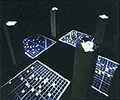Interaction 95 |
1999.09.01 |
1962 Born in Kira-machi, Aichi Prefecture 1985 Completed the plastic arts curriculum in the art division of Tsukuba University 1987 Completed the plastic arts curriculum in the design program of the art research department of the graduate school of Tsukuba University After entering the university in 1981, I began creating experimental animated works in 8 mm film and video. In 1982, my modern version of the odorokiban, a persistence-of-vision parlor toy that was a primitive moving picture device, won a prize in the first OMNI art contest. Since then, having an interest in flip books and other visual toys that predate cinema, I created many animated objets. Time Stratum I, my 1985 video installation, won the gold prize in the High Technology Art contest. Time Stratum II won the Grand Prix at the 17th Contemporary Japanese Arts Exhibition. I have since exhibited in many art exhibitions in Japan and overseas. Becoming interested in computer games as audio-visual systems in 1986, in 1987, I created Otocky, a visual music game, as video game software. From the fall of 1990, I have been responsible for video art using computer graphics in the Fuji Television program Einstein. In the fall of 1991 I began an eight month residence as a guest artist at the Exploratorium in San Francisco. In 1992, I exhibited in the Japanese Pavilion at the Seville Expo in Spain. In 1992-94 I built a video system combining live images and computer graphics for the Fuji Television children’s program Ugo-ugo-ruga. In addition to pure art, I created many videos using computer graphics for TV programs and commercials. Since 1994, I have been a guest artist at ZKM in Karlsruhe, Germany, during which period I held large one-man shows in Germany, Finland, and the Netherlands. Resonance of 4  This is an interactive audio-visual installation which allows four people to create one musical composition in co-operation with each other. In this installation, four players are given different tones with which they can compose their own melody each using a mouse to put dots on four grid images that are projected on the floor. I hope that each player will try to listen to the melodies which are being created by the other players and then try to change their melody to make a better harmony. In this way, the installation would not only perform a resonance of sounds, but would also create a resonance of the minds of the four players. This is an interactive audio-visual installation which allows four people to create one musical composition in co-operation with each other. In this installation, four players are given different tones with which they can compose their own melody each using a mouse to put dots on four grid images that are projected on the floor. I hope that each player will try to listen to the melodies which are being created by the other players and then try to change their melody to make a better harmony. In this way, the installation would not only perform a resonance of sounds, but would also create a resonance of the minds of the four players. |
| Interaction 95 >> | |
E-Mail : info@iamas.ac.jp |
